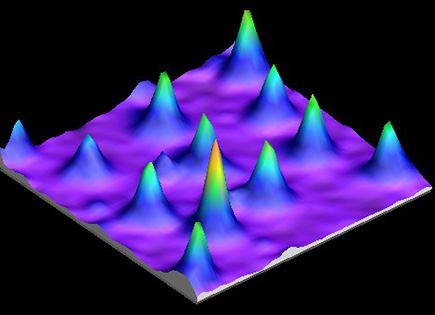Projects
Project: Atomic-scale design of low-dimensional topological superconductors hosting Majorana bound states and dispersive Majorana edge channelsHowon Kim and Dominik Schreyer |
||

We utilize low-temperature scanning tunneling microscopy and spectroscopy combined with single-atom manipulation techniques and concepts of atomic-scale interface engineering to artificially design and locally investigate low-dimensional topological superconducting systems with highest spatial, energy and spin resolution. In particular, we focus on magnet-superconductor hybrid systems having a large superconducting pairing energy and a strong spin-orbit interaction. Artificially built magnetic atom chains as well as 2D arrays of magnetic adatoms on elemental superconductors provide extremely well defined platforms for studying the characteristics of Majorana bound states and dispersive 1D Majorana edge channels, respectively, thereby facilitating the comparison between experimental results and theoretical predictions. Picture: A single-crystal rhenium substrate with an ultrathin surface oxide layer induces a topological superconducting state into a nano-scale iron island which exhibits a dispersive 1D Majorana edge mode. |
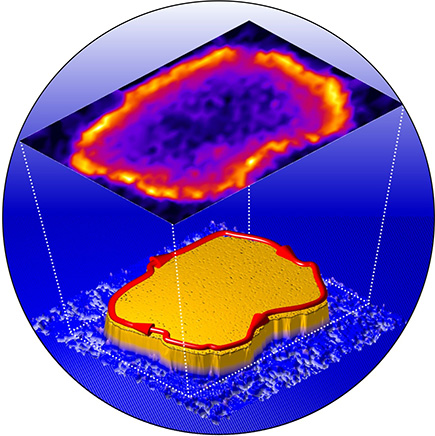 |
|
Bottom-up design of magnetic nanostructures on superconducting surfacesPhilip Beck, Lucas Schneider and Jens Wiebe |
||

Interfacing magnetic materials with superconductors can give rise to a variety of interesting physical phenomena. We start from the smallest possible magnetic impurity, i.e. a single magnetic adatom, which we deposit on the surface of a superconducting sample. Using a scanning tunneling microscope (STM) operating at 0.3 Kelvin, we investigate how such impurities locally induce bound states in the superconductor. Furthermore, we use the tip of the STM to laterally move single magnetic atoms across the surface of our superconducting substrates. In this way, we assemble different magnetic nanostructures such as 1D chains and 2D arrays atom-by-atom. Magnetic nanowires proximity coupled to an s-wave superconductor can host exotic quasiparticles, the so-called Majorana bound states (MBS), being good candidates for future qubits in topological quantum computation. With our bottom-up approach of constructing the nanowires, we have perfect control over chemical or geometrical disorder and we can study the emergence of intragap states and MBS in the wires with increasing length. |
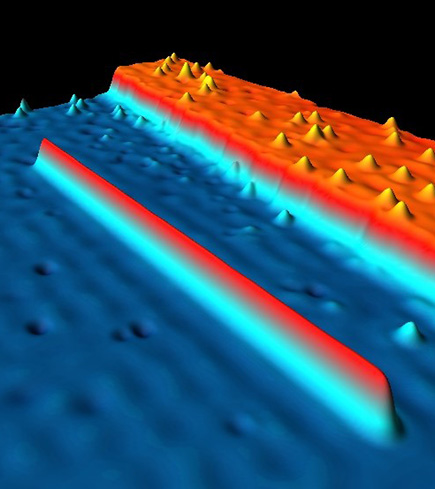
Picture: One-dimensional nanowire consisting of 101 exactly positioned magnetic Manganese atoms on the surface of the elemental superconductor Rhenium. |
|
Emergence of exotic states in metal-organic molecular chains interacting with superconductorsJulia Goedecke |
||
 The presence of magnetic adsorbates, either single atoms or molecules, on a superconductor surface results in a Cooper pair breaking potential, thereby leading to so-called Yu-Shiba-Rusinov (YSR) states. Arranging those magnetic atoms or molecules linearly to form 1D chains on superconducting substrates can result in the formation of a 1D YSR-band and the emergence of topological superconductivity within the chain with Majorana zero-energy modes at its ends. These Majorana states are of special interest because they can serve as robust qubits and thus as a basis for topological quantum computing. As a model-type platform, we study magnetic molecules such as 5,5'-dibromosalophenes (which are very well suited for surface investigations due to their chemical structure and properties) with different magnetic metal centers on different elemental superconducting substrates. The investigations focus on the interactions of molecular spins on the superconducting surfaces as well as on the emergence of novel types of exotic states in molecular chain – superconductor hybrid systems. For this purpose, we perform spin-resolved STM and STS at low temperatures and in external magnetic fields.
The presence of magnetic adsorbates, either single atoms or molecules, on a superconductor surface results in a Cooper pair breaking potential, thereby leading to so-called Yu-Shiba-Rusinov (YSR) states. Arranging those magnetic atoms or molecules linearly to form 1D chains on superconducting substrates can result in the formation of a 1D YSR-band and the emergence of topological superconductivity within the chain with Majorana zero-energy modes at its ends. These Majorana states are of special interest because they can serve as robust qubits and thus as a basis for topological quantum computing. As a model-type platform, we study magnetic molecules such as 5,5'-dibromosalophenes (which are very well suited for surface investigations due to their chemical structure and properties) with different magnetic metal centers on different elemental superconducting substrates. The investigations focus on the interactions of molecular spins on the superconducting surfaces as well as on the emergence of novel types of exotic states in molecular chain – superconductor hybrid systems. For this purpose, we perform spin-resolved STM and STS at low temperatures and in external magnetic fields. |
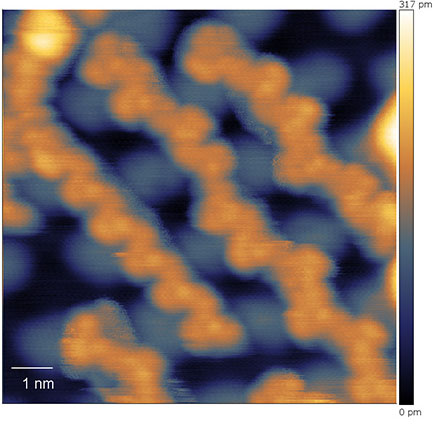
Picture: STM image of polymerized 5,5'-dibromosalophenato-cobalt chains on Co-intercalated graphene on superconducting Ir(111). |
|
Detecting and manipulating Majorana states in hybrid structures involving non-collinear magnets and superconductorsWenbin Li |
||
 The interaction between non-collinear magnetism and superconductivity can lead to novel exotic states, like Majorana quasiparticles. By means of molecular beam epitaxy (MBE), we grow ultrathin magnetic films on top of elemental superconductors and then detect the signatures of Majorana quasiparticles using low-temperature spin-polarized scanning tunneling microscopy and spectroscopy. Moreover, by manipulating the non-collinear magnetic states by means of the spin-polarized STM tip, we intend to create a topological Majorana switch and demonstrate the controlled manipulation of Majorana states The interaction between non-collinear magnetism and superconductivity can lead to novel exotic states, like Majorana quasiparticles. By means of molecular beam epitaxy (MBE), we grow ultrathin magnetic films on top of elemental superconductors and then detect the signatures of Majorana quasiparticles using low-temperature spin-polarized scanning tunneling microscopy and spectroscopy. Moreover, by manipulating the non-collinear magnetic states by means of the spin-polarized STM tip, we intend to create a topological Majorana switch and demonstrate the controlled manipulation of Majorana states
Picture: Non-collinear spin spiral on top of a superconducting substrate. |
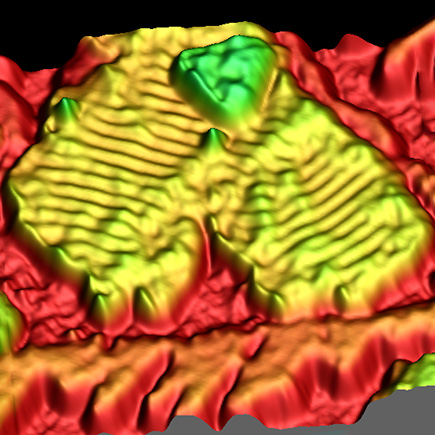 |
|
Designing Majorana states in epitaxially grown heterostructures of topological insulators and superconductorsXiaochun Huang |
||
Picture: Schematic diagram of the combined MBE/STM system. |
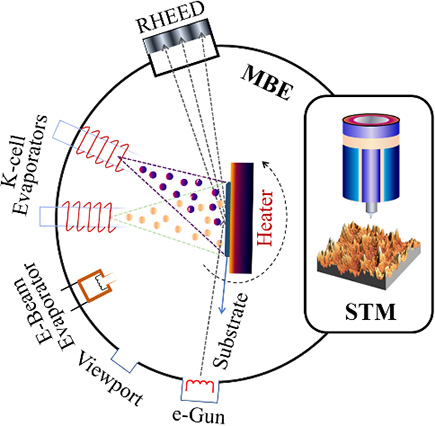 |
|
Probing Majorana quasiparticles in iron-based superconductorsDongfei Wang |
||
|
Picture: Majorana quasiparticle lattice in an iron-based superconductor |
|
Topological effects of magnetic adatom arrays on superconductors: Theory and SimulationJannis Neuhaus-Steinmetz, Thore Posske, and Elena Vedmedenko |
||
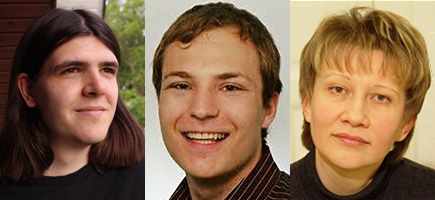 The interplay of non-collinear magnetic structures and superconductivity has interesting prospects in the realm of topologically protected electronic states and quantum computing. The recent progress in the experimental abilities to manipulate such structures atom-by-atom demands for new theoretical efforts to account for these developments. We combine Monte-Carlo and tight-binding calculations with analytical methods to determine the topological electronic properties of few-layer structures and especially designed magnetic systems on superconductors. The goal is to identify novel grounds for topological electronic effects. Especially, we desire to help experimentalists to identify and make use of material systems with topologically nontrivial electronic properties, in particular Majorana bound states, dispersive Majorana 1D channels, and other exotic quasiparticle excitations. |
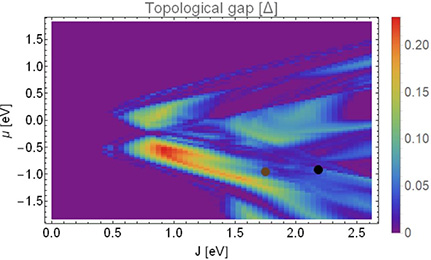 Picture: Topological gap of a magnetic topological superconductor |
|
 By coupling the nontrivial edge states of topo-logical insulators with superconductors, one can construct topological superconductors providing Majorana modes at their edges as maximally entangled quasi-particles. Majorana modes should be present as zero-energy bound states and may be used as building blocks in topological quantum computing due to their favorable resilience to local perturba-tions. We use molecular beam epitaxy (MBE) for the growth of chalcogenide-based hetero-structures to build such platforms containing Majorana quasiparticles. Spin polarized scan-ning tunneling microscopy/spectroscopy (STM/STS) measurements will be performed to investigate the behavior of Majorana states at low temperatures and high magnetic fields.
By coupling the nontrivial edge states of topo-logical insulators with superconductors, one can construct topological superconductors providing Majorana modes at their edges as maximally entangled quasi-particles. Majorana modes should be present as zero-energy bound states and may be used as building blocks in topological quantum computing due to their favorable resilience to local perturba-tions. We use molecular beam epitaxy (MBE) for the growth of chalcogenide-based hetero-structures to build such platforms containing Majorana quasiparticles. Spin polarized scan-ning tunneling microscopy/spectroscopy (STM/STS) measurements will be performed to investigate the behavior of Majorana states at low temperatures and high magnetic fields.  Majorana quasiparticles, with their non-abelian statistics, are the building blocks for the next generation topological quantum computer. Evidences for Majorana quasiparticles have been discovered in several condensed matter systems. With their intrinsic topological surface states and high critical temperatures, iron-based superconductors provide an ideal platform for investigating the nature of Majorana quasiparticles. We use scanning tunneling microscopy (STM) and spectroscopy (STS) at low temperatures and high magnetic fields to explore the fascinating world of Majorana quasiparticles in the center of superconducting vortices of iron-based superconductors. In particular, we aim at a clear distinction between topologically non-trivial vortex core states and trivial Caroli – de Gennes – Matricon states by spin-polarized STM/STS.
Majorana quasiparticles, with their non-abelian statistics, are the building blocks for the next generation topological quantum computer. Evidences for Majorana quasiparticles have been discovered in several condensed matter systems. With their intrinsic topological surface states and high critical temperatures, iron-based superconductors provide an ideal platform for investigating the nature of Majorana quasiparticles. We use scanning tunneling microscopy (STM) and spectroscopy (STS) at low temperatures and high magnetic fields to explore the fascinating world of Majorana quasiparticles in the center of superconducting vortices of iron-based superconductors. In particular, we aim at a clear distinction between topologically non-trivial vortex core states and trivial Caroli – de Gennes – Matricon states by spin-polarized STM/STS. 